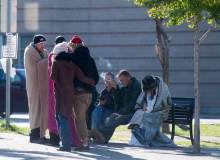This is an archived article that was published on sltrib.com in 2016, and information in the article may be outdated. It is provided only for personal research purposes and may not be reprinted.
What began Tuesday as an urgent effort to find money for new homeless-services sites in Salt Lake City became a $30 million budget overhaul, largely in the name of housing.
By diverting money from a series of spending proposals for the city's urban-renewal agency, members of the Salt Lake City Council amassed an $11.8 million fund for buying property for at least four facilities to serve the homeless.
Those land purchases, likely to begin within weeks, are part of a state, county and city initiative to build new 150-bed facilities to alleviate conditions for the hundreds of people who gather around Salt Lake City's Rio Grande Street daily.
Then the City Council kept going.
Led by members Erin Mendenhall and Derek Kitchen, the council continued to pluck budget items from the city's Redevelopment Agency (RDA), eventually pulling out another $21 million and putting it directly toward affordable housing.
The new funds are being taken from 23 separate line items aimed at projects across the city, ranging from smaller public art and park improvements to major initiatives and studies tied to development along North Temple, in the Marmalade District and downtown, among other areas.
Making available "deeply affordable housing," Kitchen said, trumped all other RDA priorities. "The point," he said, "is not to make a little dip, but a huge splash."
"The solution to homelessness is housing," the first-term councilman said sternly. "We can't talk about siting shelters without talking about housing."
The council and Mayor Jackie Biskupski have identified affordable housing as a top priority, in light of an estimated gap of 7,400 dwellings within reach of working-class, low-income and impoverished residents.
Earlier this year, Mendenhall proposed in an RDA meeting that at least a $4.5 million fund would be aimed at offsetting land costs and allowing more city-backed affordable housing projects to be located on the city's east side.
The idea, she said then, is to place more disadvantaged residents in housing located in areas richer in economic opportunity.
That money is slated to be added to the newly created fund. Councilman James Rogers said the council would begin discussions on how to spend the new funds, possibly as soon as next week.
Mike Akerlow, the city's director of housing and neighborhood development, said some of it likely would go to a voucher program to help struggling residents stay in their homes by subsidizing rents.
Another portion, Akerlow said, could go toward creating a community land trust, aimed at encouraging and preserving affordable housing citywide.
Kitchen also urged that some of the funds be used for immediate relief for the chronically homeless people who are using the Road Home shelter on Rio Grande as permanent housing.
The council's moves caught some officials off guard. Minutes before the vote, a top Biskupski staffer asked for more time to review what impact the budget changes would have, especially for the city's newly bolstered initiatives for economic development.
David Litvack, Biskupski's deputy chief of staff, said the mayor also recognized the need for affordable housing. "But we're seeing this for the first time," he said. "We're asking for time to balance priorities."
Kitchen and Mendenhall said they would consider a delay only if Biskupski guaranteed to replace money taken away from the new affordable-housing fund with cash from other city sources.
Kitchen called the RDA budget amendments "a sea change compared to what we've done in the past. ... I'm not willing to go back on the progress we've made here today."
The council eventually rejected any delay, voting 5-1 in favor of the RDA budget changes. Only Councilman Andrew Johnston, who cast the lone dissenting vote, was amenable to giving the mayor more time.
"If it's right today," Johnston said, "it'll be right next month."
About $9.8 million of the money for homeless-facility sites came from cash on hand and balances in the RDA's revolving loan fund, with another $2 million drawn from programs to develop State Street, the 9 Line corridor and midblock streets citywide.
Councilwoman and RDA Chairwoman Lisa Adams said the city hopes the Utah Legislature will pay back that cash when it convenes in January, "though it's not guaranteed," she added.
Moving up to $21.1 million of RDA funds from existing projects to affordable housing has wider implications. While some RDA initiatives may instead be paid for by imposing fees on developers, others may not be funded.
The effort made good on a long-term policy goal, Kitchen said, pitching the city's dire lack of affordable dwellings in economic terms.
"There is no greater economic development," he told colleagues, "than pushing an ambitious housing initiative forward."
"I'm really proud of us," Kitchen said, "for finding this money."
Twitter: @TonySemerad



